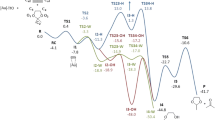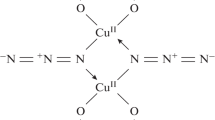Abstract
Alkynes are one of the most important groups of building blocks in organic chemistry as they work as nucleophiles upon deprotonation of its acidic hydrogen. On the surface of a gold catalyst the reactivity of an alkyne towards dehydrogenation depends on the stability of the resulting acetylide species and on its Brønsted acidic behavior with respect to other species in the system. Herein, we study the reaction of alkynes on an oxygen-covered gold surface, hereafter described as O/Au, with and without species able to build acid–base pairs on the surface. As expected, alkynes undergo a facile dehydrogenation process, forming acetylide species and coupling products such as CH3–CC–CC–CH3 from propyne (CH3–CC–H). However, temperature-programmed reactions show that the catalytic intermediates are strongly attached to the surface, leading to parallel decomposition pathways that result in the carbon poisoning of the catalyst. The strong attachment suggests that the alkynes can displace species known to undergo facile dehydrogenation on gold, such as adsorbed alkoxy, as demonstrated by experiments using selected alcohols and alkynes. Moreover, alkynes can even displace alcohols of similar molecular weight (acetylene vs. methanol; phenylacetylene vs. phenol). The results indicate that a gold catalyst facilitates the formation of acetylide species and coupling products, even though their strong interaction with the surface may be counterproductive, as it results in their decomposition.
Graphical Abstract







Similar content being viewed by others
References
Zhao F, Jia X, Li P et al (2017) Catalytic and catalyst-free diboration of alkynes. Org Chem Front 4:2235–2255
Heravi MM, Dehghani M, Zadsirjan V et al (2019) Alkynes as privileged synthons in selected organic name reactions. Curr Org Synth 16(2):205–243
Garba MD, Jackson SD (2017) Catalytic upgrading of refinery cracked products by trans-hydrogenation: a review. Appl Petrochem Res 7(1):1–8. https://doi.org/10.1007/s13203-016-0173-y
Cordoba M, Coloma-Pascual F, Quiroga ME et al (2019) Olefin purification and selective hydrogenation of alkynes with low loaded Pd nanoparticle catalysts. Ind Eng Chem Res 58(37):17182–17194. https://doi.org/10.1021/acs.iecr.9b02081
Desai SP, Ye J, Zheng J et al (2018) Well-defined rhodium-gallium catalytic sites in a metal-organic framework: promoter-controlled selectivity in alkyne semihydrogenation to E-alkenes. J Am Chem Soc 140(45):15309–15318. https://doi.org/10.1021/jacs.8b08550
Xu X, Yang Y, Zhang X et al (2018) Direct synthesis of quinolines via Co(III)-catalyzed and DMSO-involved C-H activation/cyclization of anilines with alkynes. Org Lett 20(3):566–569. https://doi.org/10.1021/acs.orglett.7b03673
Chakrasali P, Kim K, Jung YS et al (2018) Visible-light-mediated photoredox-catalyzed regio- and stereoselective chlorosulfonylation of alkynes. Org Lett 20(23):7509–7513. https://doi.org/10.1021/acs.orglett.8b03273
Loginov DA, Konoplev VE (2018) Oxidative coupling of benzoic acids with alkynes: catalyst design and selectivity. J Organomet Chem 867:14–24
Semba K, Nakao Y (2019) Cross-coupling reactions by cooperative Pd/Cu or Ni/Cu catalysis based on the catalytic generation of organocopper nucleophiles. Tetrahedron 75:709–719
Li C-J (2010) The development of catalytic nucleophilic additions of terminal alkynes in water. Acc Chem Res 43(4):581–590. https://doi.org/10.1021/ar9002587
Trost BM, Weiss AH (2009) The enantioselective addition of alkyne nucleophiles to carbonyl groups. Adv Synth Catal 351(7–8):963–983
Cassar L (1975) Synthesis of aryl- and vinyl-substituted acetylene derivatives by the use of nickel and palladium complexes. J Organomet Chem 93:253–257
Dieck HA, Heck FR (1975) Palladium catalyzed synthesis of aryl, heterocyclic and vinylic acetylene derivatives. J Organomet Chem 93(2):259–263
Sonogashira K, Tohda Y, Hagihara N (1975) A convenient synthesis of acetylenes: catalytic substitutions of acetylenic hydrogen with bromoalkenes, iodoarenes and bromopyridines. Tetrahedron Lett 16(50):4467–4470
Altenhoff G, Würtz S, Glorius F (2006) The first palladium-catalyzed Sonogashira coupling of unactivated secondary alkyl bromides. Tetrahedron Lett 47(17):2925–2928
Yi J, Lu X, Sun Y-Y et al (2013) Nickel-catalyzed Sonogashira reactions of non-activated secondary alkyl bromides and iodides. Angew Chem Int Ed 52(47):12409–12413. https://doi.org/10.1002/anie.201307069
Porey S, Zhang X, Bhowmick S et al (2020) Alkyne linchpin strategy for drug: pharmacophore conjugation: experimental and computational realization of a meta -selective inverse Sonogashira coupling. J Am Chem Soc 142(8):3762–3774. https://doi.org/10.1021/jacs.9b10646
Dong X-Y, Zhang Y-F, Ma C-L et al (2019) A general asymmetric copper-catalysed Sonogashira C(sp3)–C(sp) coupling. Nat Chem 11(12):1158–1166
Gilmore K, Alabugin IV (2011) Cyclizations of alkynes: revisiting Baldwins rules for ring closure. Chem Rev 111:6513–6556. https://doi.org/10.1021/cr200164y
Echavarren AM, Muratore ME, López-Carrillo V et al (2004) Gold-catalyzed cyclizations of alkynes with alkenes and arenes. Organic reactions. Wiley, Hoboken, pp 1–288
Rossy C, Majimel J, Delapierre MT et al (2014) Palladium and copper-supported on charcoal: a heterogeneous multi-task catalyst for sequential Sonogashira-click and click-heck reactions. J Organomet Chem 755:78–85
Bai X, Wu C, Ge S et al (2020) Pd/Cu-catalyzed enantioselective sequential heck/Sonogashira coupling: asymmetric synthesis of oxindoles containing trifluoromethylated quaternary stereogenic centers. Angew Chem 132(7):2786–2790. https://doi.org/10.1002/ange.201913148
Molnar A (2013) Palladium-catalyzed coupling reactions: practical aspects and future developments. Wiley. p. 692. Available from: https://www.wiley.com/en-us/Palladium+Catalyzed+Coupling+Reactions%3A+Practical+Aspects+and+Future+Developments-p-9783527332540. Accessed Jan 25 2021
Gholinejad M, Bahrami M, Nájera C et al (2018) Magnesium oxide supported bimetallic Pd/Cu nanoparticles as an efficient catalyst for Sonogashira reaction. J Catal 363:81–91
Glaser C (1869) Beiträge zur Kenntniss des Acetenylbenzols. Berichte der Dtsch Chem Gesellschaft 2(1):422–424. https://doi.org/10.1002/cber.186900201183
Hay AS (1962) Oxidative coupling of acetylenes. II. J Org Chem 27:3320–3321. https://doi.org/10.1021/jo01056a511
Corma A, Juárez R, Boronat M, Sánchez F et al (2011) Gold catalyzes the Sonogashira coupling reaction without the requirement of palladium impurities. Chem Commun 47(5):1446–1448
Kanuru VK, Kyriakou G, Beaumont SK et al (2010) Sonogashira coupling on an extended gold surface in vacuo: reaction of phenylacetylene with iodobenzene on Au(111). J Am Chem Soc 132(23):8081–8086
Guan Y, Hensen EJM (2009) Ethanol dehydrogenation by gold catalysts: the effect of the gold particle size and the presence of oxygen. Appl Catal A: Gen 361(1–2):49–56
Behravesh E, Melander MM, Wärnå J et al (2021) Oxidative dehydrogenation of ethanol on gold: combination of kinetic experiments and computation approach to unravel the reaction mechanism. J Catal 394:193–205
Aschwanden L, Mallat T, Krumeich F et al (2009) A simple preparation of an efficient heterogeneous gold catalyst for aerobic amine oxidation. J Mol Catal A: Chem 309(1–2):57–62
Wang M, Wang F, Ma J et al (2014) Investigations on the crystal plane effect of ceria on gold catalysis in the oxidative dehydrogenation of alcohols and amines in the liquid phase. Chem Commun 50(3):292–294
Yang Y, Liu Y, Lv P et al (2018) Theoretical insight into the mechansim and origin of ligand-controlled regioselectivity in homogenous gold-catalyzed intramolecular hydroarylation of alkynes. J Org Chem 83(5):2763–2772. https://doi.org/10.1021/acs.joc.7b03213
Lonca GH, Tejo C, Chan HL et al (2017) Gold(i)-catalyzed 6-endo-dig azide-yne cyclization: efficient access to 2H–1,3-oxazines. Chem Commun 53(4):736–739
Minnihan EC, Colletti SL, Toste FD et al (2007) Gold(I)-catalyzed regioselective cyclizations of silyl ketene amides and carbamates with alkynes. J Org Chem 72(16):6287–6289. https://doi.org/10.1021/jo071014r
Alyabyev SB, Beletskaya IP (2018) Gold as a catalyst. Part II. Alkynes in the reactions of carbon–carbon bond formation. Russ Chem Rev 87(10):984–1047. https://doi.org/10.1070/RCR4815
Schmidbaur H, Schier A (2010) Gold η2-coordination to unsaturated and aromatic hydrocarbons: the key step in gold-catalyzed organic transformations. Organometallics 29:2–23. https://doi.org/10.1021/om900900u
Rodriguez-Reyes JCF, Siler CGF, Liu W et al (2014) Van der Waals interactions determine selectivity in catalysis by metallic gold. J Am Chem Soc 136(38):13333–13340
Rodríguez-Reyes JCF, Friend CM, Madix RJ (2012) Origin of the selectivity in the gold-mediated oxidation of benzyl alcohol. Surf Sci 606(15–16):1129–1134
Personick ML, Madix RJ, Friend CM (2017) Selective oxygen-assisted reactions of alcohols and amines catalyzed by metallic gold: paradigms for the design of catalytic processes. ACS Catal 7:965–985. https://doi.org/10.1021/acscatal.6b02693
Karakalos S, Xu Y, Cheenicode Kabeer F et al (2016) Noncovalent bonding controls selectivity in heterogeneous catalysis: coupling reactions on gold. J Am Chem Soc 138(46):15243–15250. https://doi.org/10.1021/jacs.6b09450
Rodríguez-Reyes JCF, Friend CM, Madix RJ (2018) Selective activation of methyl C–H bonds of toluene by oxygen on metallic gold. Catal Lett 148(7):1985–1989
Williams CG, Wang M, Skomski D et al (2017) Metal-ligand complexation through redox assembly at surfaces characterized by vibrational spectroscopy. J Phys Chem C 121(24):13183–13190. https://doi.org/10.1021/acs.jpcc.7b02809
Personick ML, Zugic B, Biener MM et al (2015) Ozone-activated nanoporous gold: a stable and storable material for catalytic oxidation. ACS Catal 5(7):4237–4241
Xu B, Madix RJ, Friend CM (2010) Achieving optimum selectivity in oxygen assisted alcohol cross-coupling on gold. J Am Chem Soc 132(46):16571–16580. https://doi.org/10.1021/ja106706v
Saliba N, Parker DH, Koel BE (1998) Adsorption of oxygen on Au(111) by exposure to ozone. Surf Sci 410(2–3):270–282
Cheenicode Kabeer F, Chen W, Madix RJ et al (2017) First-principles study of alkoxides adsorbed on Au(111) and Au(110) surfaces: assessing the roles of noncovalent interactions and molecular structures in catalysis. J Phys Chem C 121(50):27905–27914. https://doi.org/10.1021/acs.jpcc.7b06641
Xu B, Madix RJ, Friend CM (2013) Alkyl groups as synthetic vehicles in gold-mediated oxidative-coupling reactions. Phys Chem Chem Phys 15:3179–3185. https://doi.org/10.1039/C3CP43956A
Liu X, Xu B, Haubrich J et al (2009) Surface-mediated self-coupling of ethanol on gold. J Am Chem Soc 131(16):5757–5759. https://doi.org/10.1021/ja900822r
Mcllroy A, Nesbitt DJ (1989) High-resolution, slit jet infrared spectroscopy of hydrocarbons: quantum state specific mode mixing in CH stretch-excited propyne. J Chem Phys 91(1):104–113. https://doi.org/10.1063/1.457496
Linstrom PJ, Mallard WG. NIST Chemistry WebBook, NIST Standard Reference Database Number 69 [Internet]. Gaithersburg MD, 20899: National Institute of Standards and Technology. Available from: https://webbook.nist.gov/chemistry/. Accessed 24 Feb 2021
Réocreux R, Fampiou I, Stamatakis M (2021) The role of oxygenated species in the catalytic self-coupling of MeOH on O pre-covered Au(111). Faraday Discuss. Available from: https://pubs.rsc.org/en/content/articlehtml/2021/fd/c9fd00134d. Accessed 7 Apr 2021
Xu B, Liu X, Haubrich J et al (2009) Selectivity control in gold-mediated esterification of methanol. Angew Chem Int Ed 48(23):4206–4209. https://doi.org/10.1002/anie.200805404
Boyd DRJ, Thompson HW (1952) The infra-red spectrum of methyl acetylene. Trans Faraday Soc 48:493–501
Williams VZ (1945) Infrared and Raman spectra of polyatomic molecules (Herzberg, Gerhard). J Chem Educ 22(11):572. https://doi.org/10.1021/ed022p572.1
Duncan JL (1964) The calculation of force constants and normal coordinates—V constrained force fields for a series of methyl and dimethyl compounds of 3-fold symmetry. Spectrochim Acta 20(7):1197–1221
Shimanouchi T (1972) Tables of molecular vibrational frequencies, Consolidated Volume 1. National Standard Reference Data Series, National Bureau of Standards, NSRDS-NBS 39, Washington DC.
Falk M, Whalley E (1961) Infrared spectra of methanol and deuterated methanols in gas, liquid, and solid phases. J Chem Phys 34(5):1554–1568. https://doi.org/10.1063/1.1701044
Acknowledgements
We would like to thank the valuable support of Prof. Cynthia Friend during the stages of experimental design, data analysis and for very fruitful discussions. Ms. Karinna Visurraga (UTEC) is acknowledged for administrative support.
Funding
This work was funded by UTEC Faculty Grant No. 819051 to promote international exploratory collaborative research with Harvard University. EM acknowledges the Ito Foundation for International Education Exchange for financial support. IMASC (Harvard) is acknowledged for partial support.
Author information
Authors and Affiliations
Corresponding author
Ethics declarations
Conflict of interest
The authors declare no conflict of interest.
Additional information
Publisher's Note
Springer Nature remains neutral with regard to jurisdictional claims in published maps and institutional affiliations.
Supplementary Information
Below is the link to the electronic supplementary material.
Rights and permissions
About this article
Cite this article
Chipoco Haro, D.A., Muramoto, E., Madix, R.J. et al. The Reaction of Alkynes with Model Gold Catalysts: Generation of Acetylides, Self-coupling and Surface Decomposition. Catal Lett 152, 3066–3075 (2022). https://doi.org/10.1007/s10562-021-03882-4
Received:
Accepted:
Published:
Issue Date:
DOI: https://doi.org/10.1007/s10562-021-03882-4




